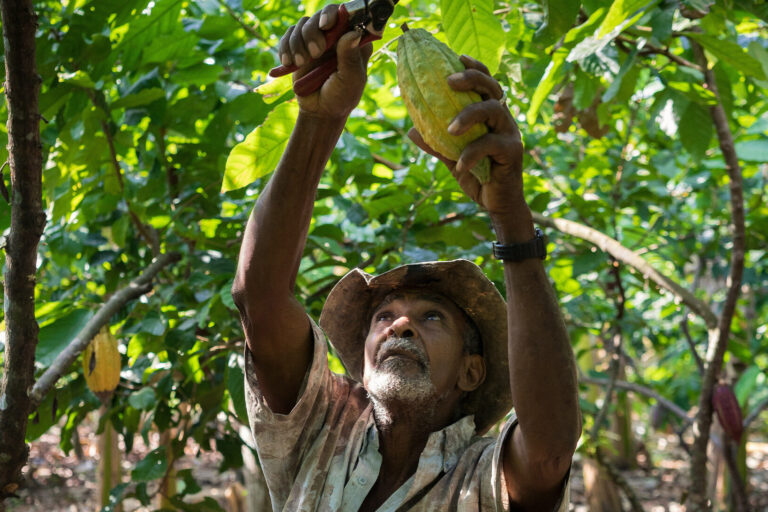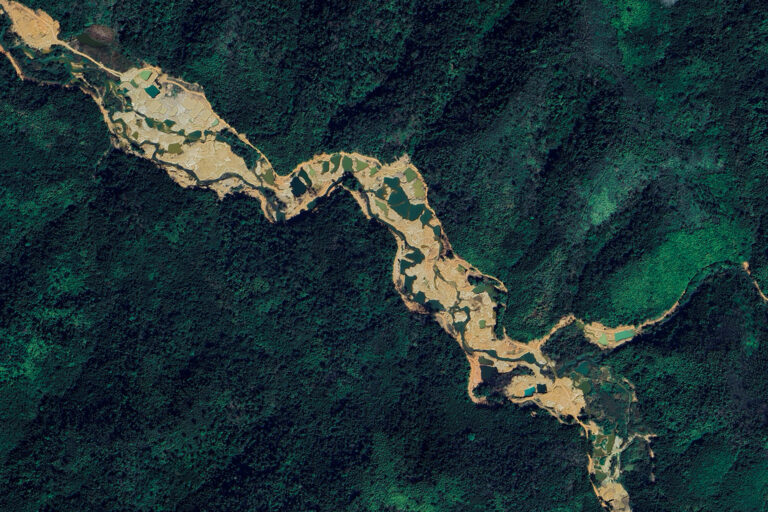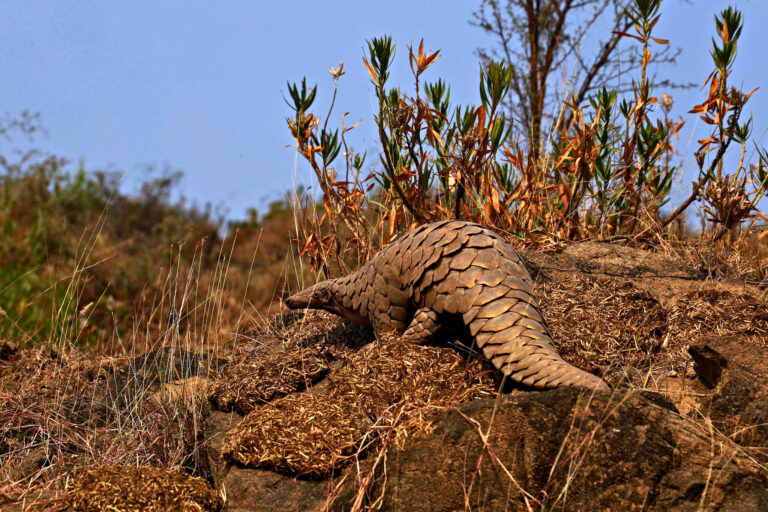- Researchers in Brazil have implanted the first subcutaneous heart rate monitoring devices on wild maned wolves, South America’s largest canid; they want to map the stress levels that a human-dominated habitat entails.
- The Cerrado savanna, one of the key habitats of the maned wolf, has been heavily deforested to make space for crops and cattle pastures, pushing the species closer to the edges of the cities.
- Without prey to hunt, maned wolves are also invading chicken farms, generating conflicts with the farmers, who usually shoot them; researchers have been working with the farmers to use them as allies in preserving the species.
- In addition to stress, which affects the reproduction and, ultimately, the survival of the species, canine scabies — probably transmitted by domestic dogs — also poses a serious threat to the maned wolf’s conservation.
In the pitch dark, biologist Rogério Cunha de Paula, who has been researching the maned wolf (Chrysocyon brachyurus) for 25 years, and his colleague Ricardo Pires Boulhosa drive through the dusty sugar cane plantations in the northeastern region of São Paulo state with two cages firmly tied to the back of the pickup. They barely see anything and get easily lost amid the high reeds. Fortunately, Rogério has a GPS. Before midnight, the cages are installed along with camera traps on the top of a mountain overlooking the city of São José do Rio Pardo. The high-voltage cables surrounding them are no obstacle for the wolves, who are lured into the cage by its contents: chicken, bacon and sardines.
With finesse and years of experience, Rogério, who is the program coordinator of CENAP (the National Research Center for Carnivore Mammals Conservation), makes the notch in the wood a little deeper so the wire attached to it allows the pressure plate to function optimally when the maned wolf has entered the cage with its long legs. The first steps for a successful expedition have been taken.
For two weeks, a team of biologists and veterinarians will travel around this area in the Cerrado biome to examine as many maned wolves as possible and implant subcutaneous heart rate monitoring devices into six of them to map the stress levels that a human-dominated habitat entails.
The Cerrado, a savanna-like area in central-western Brazil, is the core area of the maned wolf and also a region that is densely occupied by crops and pastures. Half of its native vegetation has already been lost to agriculture and cattle breeding. As the deforestation keeps going on, the maned wolf is pushed farther and farther to the edges of the cities, where it tries to survive in a surreal landscape.

For the first time, the researchers are measuring how human activities influence the heart rate and other physiological aspects related to cardio functioning. The outcome is likely to indicate that the stress levels of maned wolves in agricultural areas will be higher than those of wolves living in a national park. In addition to stress, which affects the reproduction and, ultimately, survival of the species, canine scabies — probably transmitted by domestic dogs — also poses a serious threat to their conservation.
The next morning, the two other team members are ready to inspect the first cages. Rosana Nogueira de Moraes, a senior research fellow at the Smithsonian Conservation Biology Institute (SCBI), in the U.S. state of Virginia, leads the heart monitoring research and is busy loading all sterile instruments into the pickup. Flávia Fiori, a veterinarian from Pró-Carnívoros (Institute for the Conservation of Neotropical Carnivores), complements the enormous amount of material with a box of test tubes and medical clothing sets.
From a distance, I see a group of curious spectators on the field at a chicken farm. Inside the cage, there is a beautiful female specimen of the maned wolf, an animal that is not a real wolf but rather looks like a fox with long legs. I come face to face with this beautiful animal, South America’s largest wild canid.
The wolf, who normally has fruit and rodents on the menu, had made a trip to a chicken farm this time. The farmers in the neighborhood who have not taken the right precautions against this chicken thief are suffering significant losses. A farmer has lost 500 chickens to the maned wolf in a few weeks. Although he only eats a few, most die from acute stress. Ricardo, who also works at Pró-Carnívoros, will talk to the farmers later to look for suitable solutions.

Lupe, a pioneer
Rogério and Flávia walk to the cage where Lupe — that’s what they call the specimen — makes powerful sounds. She has cubs somewhere nearby where she wants to go. The sound reaches far into the mountain valley. It is hot and it swarms with mosquitoes and insects. Not the ideal conditions to perform an operation. Rogério and his team decide to sedate Lupe and transport her as quickly as possible to another place, a little farther away. Away from the insects.
While Rogério tries to distract Lupe, Flávia injects the sleeping aid on her. The anesthetic begins to work. Lupe starts to yawn and slowly lies down. Flávia keeps an eye on the wolf as they carefully load her onto the tail lift of the pickup and the convoy sets off. In the blink of an eye, they end up in the new spot, a few hundred meters away from the chicken farm. There are no mosquitoes here.

While Rogério and Ricardo set up a tent to make the procedure as dust-free as possible, Rosana and Flávia get started. Lupe is lifted onto the cage so that blood samples can be taken and the heart rate can be measured. For Rosana, this is an exciting day because she will be able to bring the first heart monitor device to be implanted ever on a wild maned wolf.
Heart rate monitors have been used in humans for ages, but today, the 2.4-gram (0.08-ounce) insertable cardiac monitor donated by Medtronic for the study, is put into a maned wolf. Rosana says it will measure the negative effects of the environment on cardiac rhythms and investigate how human disruption affects the animal’s heart rate. This allows them to assess the risk of negative long-term effects on the health of individuals and populations of the endangered maned wolf. Ultimately, they want to create stress-limited, healthy environments.

When I look around, I hardly see any Cerrado but a patchwork of crops and cattle pastures. Next to the huge sugar cane plantations are the coffee fields with bare pieces of land between. If you add this to the deforestation both in the Amazon and the Atlantic rainforests, it is not surprising that maned wolves are pushed farther and farther back into a fragmented man-made maze from which escape is not possible.
Rogério collects some breast milk in a test tube, takes her body measurements and collects hair, urine and saliva that will go to CENAP for research. Rosana, meanwhile, checks her equipment and closely follows the heartbeat of her first patient. Everything runs smoothly when she inserts the heart device just under the skin. Everyone is silent when a satisfied smile appears on her face. It’s the first heart monitor device to be used on a wild maned wolf.
Lupe is not the first maned wolf to be put a heart rate monitoring device, though. At the SCBI, Rosana de Moraes collected heart rate data in captive animals over a one-year period. The stressors there are, of course, much different than in nature — a lawn mower is certainly less nerve-racking than trucks or gunshots — but the results of this previous study may foresee the measurements made in the Cerrado, yet to be released.

After inserting the monitoring device in Lupe, the items are loaded onto the back of the pickups and the wolf is carefully placed in the cage that stands in the shade under a tree. Here she can wake up quietly while we go for a coffee with the landowner.
Farmers as allies
Ricardo explains that the conversations he and Rogério have with the chicken farm owners are essential for the preservation of the maned wolf. In more distant areas, the farmers check the cages the scientists installed and immediately pass this on to the team if there is a wolf in it. Unfortunately, more and more wolves with canine scabies appear to be coming to the area around São Paulo state. The scabies is probably not only transmitted by dogs but can also be triggered by stress.
Only this year, six new wolves with scabies, also known as sarcoptic mange, were caught on camera traps in the neighborhood. The team is now struggling to capture them, investigate and provide them with the ideal treatment. Rogério and Ricardo try to get the farmers to feel responsible for the wolf and its environment. Relocating is not an option because the maned wolf is very attached to its environment.

The farmers Rogério now works with, for example, cooperate by not immediately harvesting all sugar cane at the same time but leaving certain plots intact so the wolf still has some shelter. With other farmers, he has made agreements to keep the cattle on certain pieces of land in certain periods when ripe wolf apples grow on the lobeira tree (Solanum lycocarpum), one of the maned wolf’s favorite snacks.
Rogério takes us to a lobeira tree where he wants to check a camera trap. It becomes clear that the cows that graze here are a major obstacle. There is not a single wolf on the camera this time and, because of that, he will sit down with the farmer to discuss this problem. This is the core area of Ricco, a maned wolf with scabies who loves this fruit but is too afraid of these overgrown cows.
The next morning, Ricco is seen inside one of the cages. With his bald spots and long legs, Ricco looks like a fox on stilts. He is sedated and given oral medication to treat his scabies. In three months, it will be completely gone.
Serra da Canastra
After two weeks of dusty but grateful fieldwork, we exchange the São Paulo maze for the real Cerrado. Our guide, Marcello, who is also involved in Rogério’s project, takes us in his Land Rover to the Serra da Canastra National Park, in the neighboring state of Minas Gerais. Here lives the largest population of maned wolves of South America — an estimated 200 specimens.
Our eyes have to get used to the dark because it is only 4 a.m. when Marcello detects a giant anteater. It won’t be the last. After a few hours of driving, it is already clear to us that this park is home to a wealth of flora and fauna. There are animals here that do not flourish anywhere else, such as the giant anteater (Myrmecophaga tridactyla), the giant armadillo (Priodontes maximus) and the maned wolf. We search the vast grasslands and find droppings of the wolf, although spotting the animal is very difficult.

The next evening, we set off again. The sun moves farther and farther down and spreads a beautiful red glow over the landscape. Suddenly Marcello sees the an aplomado falcon (Falco femoralis) sitting low in a tree. Now it is worth paying attention because the falcon and the maned wolf often hunt together.
I quickly change my lens to bring it closer when I suddenly come face to face with a maned wolf coming from behind the Land Rover. I stand dead silent while he elegantly continues to look for fruits and does not seem to care about my presence. His fur shines at dusk. With his sparkling eyes, he walks past the Land Rover and does not even look at us. He has an ear tag and a collar and turns out to be an acquaintance.
It is Larápio, a wolf who has been monitored by Rogério and his team for some time and always steals food and even motorcycle helmets from the guards (larápio means “thief” in Portuguese). Fortunately, they can laugh about it, but that does not apply to the chicken farmers who live on the outskirts of the park. Their chickens used to be in great demand among the wolves, so they in turn were hunted massively.
To stop this, Rogério and his team set up a project to build wolf-proof chicken coops together with the local farmers and to change their perception of the wolf. Between 2007 and 2015, a total of 150 chicken coops were built on farms adjacent to the park. Since then, the situation has calmed down and today the farmers are even happy with the maned wolf. Tourism naturally provides this mountain range in the center-south of the Brazilian state of Minas Gerais with an extra income.

Unprecedented sightings of maned wolves in Amazon herald a changing landscape
Banner image of a maned wolf in Serra da Canastra National Park, state of Minas Gerais. Image by Marielle van Uitert.













